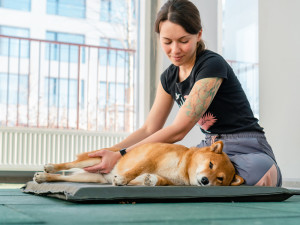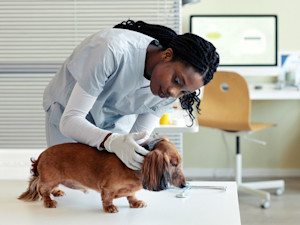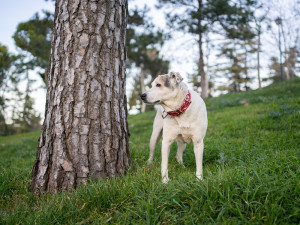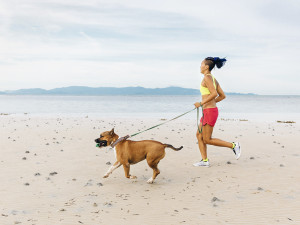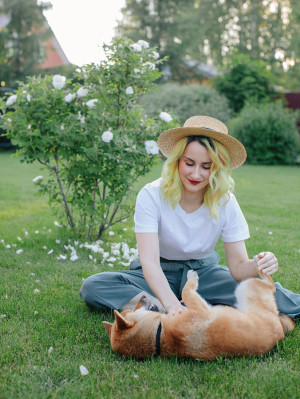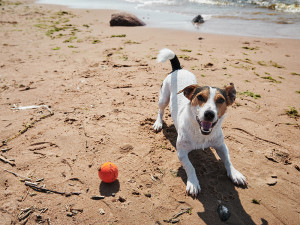Is Your Pup a Splooter? Learn More About the ‘Superman’ Stretch
Is it a bird? Is it a plane? Nope, it’s your dog all stretched out like a frog
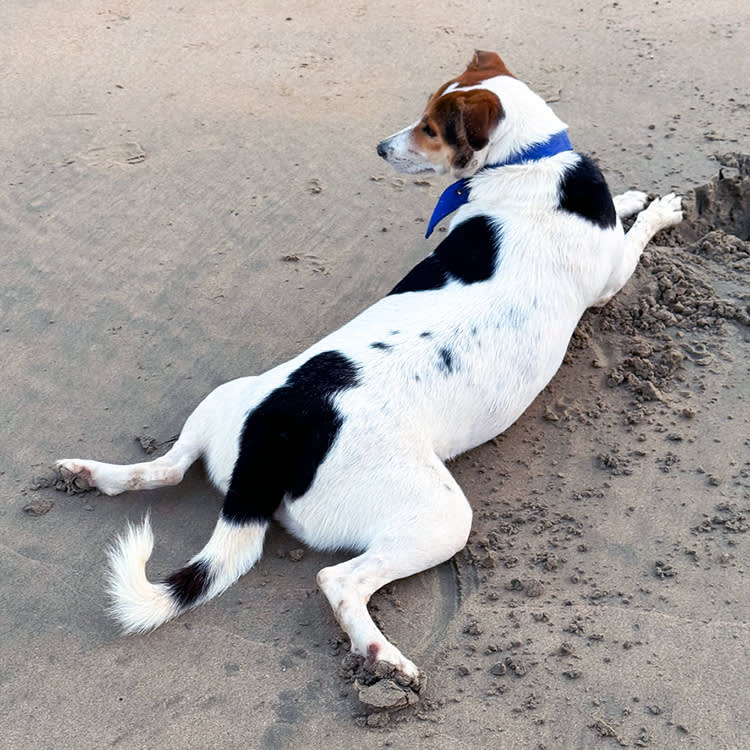
Share Article
Do you have one of those dogs who likes to lie spread-eagled, back legs stretched out behind them like a frog? Or perhaps they prefer to stretch out one leg at a time? Maybe you even have a Superman in your midst? Whatever your dog’s preference, the technical term for this cute, if quirky, pose is ‘splooting’.
While not all dogs are ‘splooters’ (yes, I might be coining a new term here), the behaviour is not uncommon either. But what exactly drives dogs to assume this peculiar frog-like stance?

littleKin™ is Kinship’s home just for puppy and kitten parents. Bop over to check out expert advice, new pet tools, and special deals—all curated for your newest family member.
opens in a new tabWell, as we know, behaviour doesn’t happen in a vacuum. There’s always a reason why dogs do what they do. So let’s explore some of the reasons for this endearing habit.
What is splooting?
Splooting is a term used to describe a specific posture that dogs (and some other four-legged mammals) adopt when lying down.
It involves:
Lying flat on the belly in a spread-eagled, prone posture.
Stretching one or both hind legs out behind the body.
Front legs may be tucked under or stretched forwards.
Splooting is sometimes referred to as ‘frogging’ or ‘pancaking’ for reasons that are self-explanatory. There are also different types of splooting, depending on your dog’s personal preferences.
Variations include:
Full sploot: both hind legs stretched out behind the body with the front legs remaining tucked underneath.
Half sploot: one hind leg stretched out at the back while the other is tucked under the body.
Side sploot: one or both hind legs are extended behind the dog as they lie on their side.
Superman sploot: Both hind legs are stretched out at the back with the front legs extended forwards, as if the dog were flying (hence the name).
Splooting isn’t exclusive to canines either. While dogs do tend to be the poster children for the behaviour, it’s been seen across a wide range of other mammals too, from squirrels to bears, cats to rabbits.
Why do dogs sploot?
This is perhaps the most intriguing question of all.In fact, splooting serves several different purposes:
Comfort and relaxation
For many dogs, splooting is simply a comfortable way to rest. The position allows them to fully relax their muscles and stretch out their lower back, hips, and shoulders. Think of it as your dog’s version of sprawling out on the couch after a long day.
Stretching and flexibility
Because splooting provides an effective way for dogs to stretch out, it can potentially help keep their muscles and joints more flexible. This can be particularly beneficial for younger dogs who are naturally more flexible, active dogs after exercise and older dogs to maintain joint mobility.
To relieve discomfort
For similar reasons, dogs may sometimes sploot to alleviate pain or discomfort.
In particular, the behaviour can help to:
Stretch stiff joints, particularly in older dogsopens in a new tab or those with injuries or arthritisopens in a new tab.
Relieve pressure on the spine or hips.
Ease muscle tensionopens in a new tab, especially after physical activity.
Our rescue cat, Oakley, who has what can best be described as a ‘dent’ in his spine from a suspected past traumatic injury, frequently adopts this position. He even takes it a step further by draping himself over a cushion or an obliging human arm to enhance the stretch. You can almost sense his relief.
Temperature regulation
Dogs don't sweat like humans doopens in a new tab, except a little bit through the pads on their paws.Instead, they rely on panting and the expansion of the blood vessels to help them cool down.
Because of this, splooting can be an effective way for dogs to regulate their body temperatureopens in a new tab, especially on hot days. By pressing their belly against a cool surface like tile, concrete, or even damp earth, they can cool themselves down much faster than by panting alone.
So, you might notice your dog splooting more often during the warmer months or after intense activity.
Breed and species tendencies
While any dog can sploot, certain breeds can be more prone to the behaviour due to their physical characteristics.
Short-legged, long-bodied breeds: Corgis, Dachshunds and Basset Hounds often sploot due to their unique body structure.
Brachycephalic breeds: breeds like Pugs and French Bulldogs may sploot more frequently to help regulate their body temperature, as their flat facesopens in a new tab can make panting less effective.
Large breeds: German Shepherds, Mastiffs and Labrador Retrievers may sploot to alleviate pressure on their hips and joints.
Anecdotally, I’ve seen Pitbulls and Staffies sploot quite a bit too.
Communication
Dogs are constantly communicating via their body language, and in some cases, splooting can serve as a useful form of non-verbal communicationopens in a new tab.
For instance, given that a dog might sploot when they are feeling relaxedopens in a new tab and unthreatened, it can be a helpful signal to both humans and other dogs. The posture communicates a sense of ease and contentment, indicating that the dog feels safe in their current environment.
This can potentially contribute to a calmer atmosphere in multi-dog households or social settings, reducing tension and promoting positive interactions.
Is splooting normal? Should you be concerned?
For the most part, splooting is a perfectly normal, harmless behaviour and many dogs sploot regularly throughout their lives without any issues.
However, as with many behaviours, there are times when splooting could indicate an underlying problem.
Signs to watch out for
As I said, while splooting is usually nothing to worry about, be alert for these potential red flags:
Sudden onset: if your dog suddenly starts splooting when they never did before, especially if they’re older, it might be worth investigating.
Difficulty getting up: if your dog struggles to stand after splooting or seems stiff, this could indicate joint problems.
Signs of painopens in a new tab: whining, excessive panting or reluctance to be touched while splooting may suggest discomfort.
Changes in mobility: limping or a reluctance to move after splooting could signal musculoskeletal issues.
When to see a vet
If your dog starts splooting frequently due to apparent discomfort, it’s important to take notice.
While the position can provide temporary relief, persistent discomfort-related splooting may indicate an underlying health issue that requires veterinary attention.
Consider consulting your veterinarian if you notice:
Any of the above signs accompanying your dog's splooting behaviour.
A significant increase in the frequency of splooting, especially in older dogs.
Splooting combined with other changes in behaviour or activity levels.
You know your dog best, so if something seems off, it's always better to err on the side of caution and seek professional advice.
Fun facts and myths about splooting
Splooting has garnered quite a bit of attention of late, leading to some interesting facts and misconceptions.
The truth about splooting
Splooting has become a popular hashtag on social media platforms, with dog lovers sharing (admittedly adorable) photos of their splooting pets.
Increased splooting behaviour in wild animals like squirrels has been noted as a potential indicator of rising temperatures due to climate change.
The term ‘sploot’ has entered popular culture, with some dictionaries (but not Merriam Webster, yet) now including it as a recognised word.
The origins of the word ‘sploot’ are unclear, but according to Dictionary.com’s Slang Dictionaryopens in a new tab, the term is, “especially associated with Welsh Corgis and is used affectionately in the internet slang of DoggoLingo.”
Myths about splooting
1. Splooting always indicates healthy hips: while splooting can be a normal behaviour, it doesn't necessarily mean a dog has healthy hips. Some dogs with hip dysplasia, osteoarthritis, or other joint issues may also sploot.
2. Only small animals sploot: animals of all sizes can and do sploot. While it might be more noticeable in smaller species, even large animals like bears have been observed splooting.
3. Splooting is always a sign of relaxation: while often associated with relaxation, splooting can sometimes indicate pain or discomfort, especially if it's a new behaviour in older dogs.
4. Splooting always means a dog is happy: while splooting can be a sign of contentment, it's not a definitive indicator of a dog's emotional state. Always consider other body language cues and what else is going on at the time to assess your dog's mood.
Frequently asked questions
Can all animals sploot?
While many animals can sploot, they don’t all have the physical capability to do so. Dogs are most known for splooting, but the behaviour is also seen in cats, squirrels, bears and other four-legged mammals.
Can all dogs sploot?
Theoretically, yes. However, some breeds, shapes or sizes of dog may find it more comfortable or natural than others, due to their body structure and flexibility.
Is splooting more common in young dogs?
A: Young dogs may sploot more frequently due to their greater flexibility. However, many dogs continue to sploot throughout their lives.
Does splooting indicate a problem with a dog's hips?
Not necessarily. While some dogs with hip issues may sploot to alleviate discomfort, plenty of healthy dogs sploot regularly. If you're concerned about your dog's hip health, it’s always best to consult with your veterinarian.
Should I encourage my dog to sploot?
There's no need to actively encourage or discourage splooting. If your dog finds it comfortable, it's generally fine to let them do it naturally.
Can splooting help dogs stay cool?
Yes, splooting on cool surfaces can help dogs regulate their body temperature, especially on hot days.
Is it okay for my dog to sploot on hard surfaces?
Generally, yes. Most dogs will choose surfaces that are comfortable for them. However, if you notice any signs of discomfort, you might want to encourage splooting on softer surfaces.
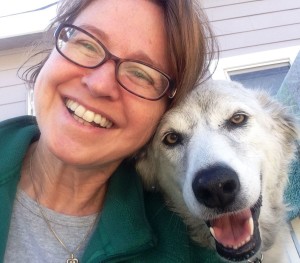
Susan Nilson
Susan Nilson is an accredited cat and dog training and behaviour professional. A long-term adopter of fearful rescue animals, in 2022 she founded The Cat And Dog Houseopens in a new tab, an authority website geared toward helping pet parents better understand their cats and dogs.
Related articles
![A woman wearing colorful activewear running on the beach with her dog.]() opens in a new tab
opens in a new tabDogs Make Great Exercise Partners
Helpful tips on staying in shape with your dog
![Woman scratching belly of Shiba Inu while sitting on lawn near bush on summer day in yard.]() opens in a new tab
opens in a new tabThe Reasons Behind Dogs’ Love For Belly Rubs
If one hand isn’t stroking a furry dog belly, what are you doing?
![Small dog humps its teddy bear toy on the room floor]() opens in a new tab
opens in a new tabHumping. Why, Though?!
Animal behaviourists weigh in on what’s behind all this bumping and grinding
![Dog playing with orange ball toy at the beach on a sunny day]() opens in a new tab
opens in a new tabA Tail-Wagging Dog Isn’t Always a Happy Dog
This body language is not as simple as you probably think
